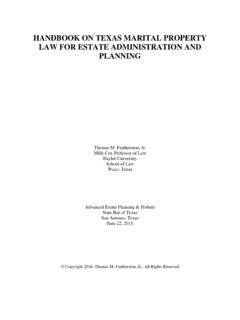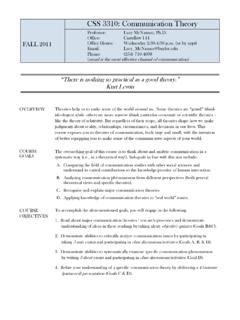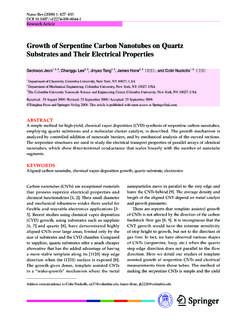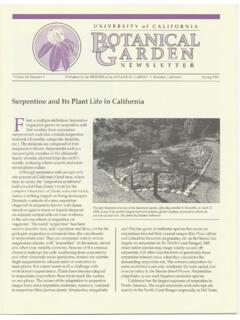Transcription of BAYLOR
1 BAYLOR FALL 1986 ulletin No. 44 The Petroleum Potential of H serpentine Plugs" and Associated Rocks, Central and South Texas TRUITT F. MATTHEWS BAYLOR Geological Studies EDITORIAL STAFF Jean M. Spencer Jenness, , environmental and medical geology O. T. Hayward, , Advisor. Cartographic Editor general and urban geology and what have you Peter M. Allen, urban and environmental geology, hydrology Harold H. Beaver, stratigraphy, petroleum geology Rena Bonem, paleontology, paleoecology William Brown, structural tectonics Robert C. Grayson, stratigraphy, conodont biostratigraphy and sedimentary petrology Don M. Greene, physical geography, climatology, earth sciences Don F. Parker, igneous geology, volcanology, mineralogy, petrology Ker Thomson, W.
2 M. Keck Foundation Chair in Geophysics Joe C. Yelderman, Jr., hydrogeology STUDENT EDITORIAL STAFF Marlow Anderson, Cartographer The BAYLOR Geological Studies Bulletin is published by the Department of Geology at BAYLOR University. The Bulletin is specifically dedicated to the dissemination of geologic knowledge for the benefit of the people of Texas. The publication is designed to present the results of both pure and applied research which will ultimately be impor-tant in the economic and cultural growth of the State. ISSN 0005-7266 Additional copies of this bulletin can be obtained from the Department of Geology, BAYLOR University, Waco, Texas 76798. $ postpaid. CONTENTS Page Abstract .. 5 Introduction.. 5 Purpose.
3 5 Location .. 6 Methods .. 6 Previous works.. 7 Acknowledgments .. 11 Regional setting of " serpentine plugs" .. 11 Descriptive geology of " serpentine plugs" .. 12 Northern subprovince .. 13 Middle subprovince .. 15 Southern subprovince .. 18 Origin and history of " serpentine plugs" .. 26 Production histories of " serpentine plugs" .. 30 Northern subprovince .. 30 Middle subprovince .. 31 Southern subprovince .. ' .. 32 Exploration for " serpentine plugs" .. 33 Zone of known " serpentine plug" occurrence .. 33 Probable extensions of that zone .. 33 Properties of " serpentine plugs" .. 33 Properties of associated features .. 34 Draping of superjacent formations .. 34 Fracturing of deeper horizons .. 34 Oil occurrence in association with " serpentine plugs".
4 34 Exploration techniques for " serpentine plugs" .. 35 Surface geology .. 35 Remote sensing .. 35 Geochemical .. 35 Magnetics .. 36 Gravity .. 36 Seismic .. 36 Exploratory drilling .. 36 Conclusions .. 37 Appendix I. Core descriptions .. 37 Appendix II. List of localities .. 38 Appendix III. List of well logs .. 39 References .. 40 Index .. 41 ILLUSTRATIONS Fig. Page I. Index map of study area.. 6 2. Base map.. 7 3. Stratigraphic section of Upper Cretaceous rocks in study area.. 8 4. Structure map, Hilbig field .. 14 5. Representative electric log, Hilbig field .. 15 6. Structural cross-section, Hilbig field .. 16-17 7. Representative diagrammatic section, " serpentine plug," northern subprovince .. 16 8. Core samples from Humble Oil & Refining Co.
5 Wolfbarger #2 .. 18 9. McKown Formation, McKinney Falls State Park .. 19 10. East-west diagrammatic cross-section, Pilot Knob .. 19 II. Representative diagrammatic section " serpentine plug," middle subprovince .. 19 12. Representative electric log, Sutil field .. 20 13. SW-NE structural cross-section, Sutil field .. 20 14. Isopach map of fine-grained volcanics, Sutil field .. 21 15. SEM photograph of sample from Petrolia Drlg. Co. Calvert #2, Sutil field .. 22 16. Photograph of thin sections from Petrolia Drlg. Co. Calvert #2, Sutil field .. 22 17. Structure map, top of volcanics, Sutil field .. 23 18. Residual structure map, Sutil field .. 24 19. Schematic model of facies associated with Elaine field volcanic complex.
6 25 20. Schematic depositional model, San Miguel and Olmos sand reservoirs .. 25 21. Representative diagrammatic section " serpentine plug," southern sUbprovince .. 26 22. Representative electric log, Torch field .. 26 23. NW-SE structural cross section C-C', Torch field .. 27 24. Structure map, Torch field .. 28 25. Idealized model of an erupting submarine volcano .. 29 26. Production graph, Hilbig field .. 30 27. Production graph, Sutil field .. 31 28. Production graph, Torch field .. 32 29. Map showing zone of known plug occurrence .. 33 30. Map showing zones for concentration of exploration efforts .. 34 31. Total intensity magnetic map of ground magnetometer survey, Hilbig field .. 35 32. Photograph of thin section, Humble Oil & Refining Co.
7 Wolfenbarger #2 .. 38 33. Photograph of thin section, Humble Oil & Refining Co. Friske #2 .. 38 34. Photograph of thin section and SEM photograph of Humble Oil & Refining Co. Wolfenbarger #2 .. 38 The Petroleum Potential of " serpentine Plugs" and Associated Rocks, Central and South Texas Truitt F. Matthews ABSTRACT During deposition of the Upper Cretaceous Austin Chalk and Taylor Marl, " serpentine plugs" were formed by submarine volcanic eruptions along major fault zones in the ancient Gulf of Mexico. The parent material was an alkaline-rich, silica-deficient basalt. After eruption, the mounds of pyroclastic material that accumulated around and over the volcanic centers underwent alteration by palagonitization, the hydration of basaltic glass.
8 The topographic highs formed by the tuff mounds subsequently controlled localized deposition of shoal-water carbonates. The " serpentine plugs" occur along an arcuate belt extending approximately 250 mi (400 km) from Milam County southwestward to Zavala County, Texas. Hydrocarbon traps in and around these plugs have yielded approximately 54 million barrels of oil and significant quantities of natural gas from altered volcanic tuff and associated shoal-water carbonates. Shallower production occurs from overlying and marginal sedimentary rocks structurally influenced by the volcanic centers. Entrapment of hydrocarbons occurs as : (I) stratigra-phic traps within porous zones of volcanic tuff; (2) stratigraphic traps within porous, high energy carbonate units; (3) structural traps within overlying and marginal sands; and (4) traps related to fracturing of brittle carbonate units.
9 Analysis of known fields suggests that there are at least three distinctive groupings of " serpentine plugs": (I) a northern subprovince in which dominant hydro-carbon saturation is in the altered volcanic tuff; (2) a middle subprovince characterized by hydrocarbon-saturated biocalcarenite facies and fracture-related production in underlying units; and (3) a southern subprovince characterized by well-developed and productive overlying and marginal sands, which locally form domes by draping over the " serpentine plugs." Each of these subprovinces appears to reflect a somewhat different geologic history. Exploration for " serpentine plugs" should be concentrated along existing fault zones related to extension. Modes of exploration include enhanced remote-sensing techniques, ground-level magnetics, and strategically placed seismic lines.
10 INTRODUCTION* PURPOSE Uniform deposition of the Upper Cretaceous (Coni-acian/Campanian) Austin Chalk and Taylor Marl was interrupted by volcanic activity in the ancient Gulf of Mexico. As a product of eruption, tuff mounds, formed by the hydration of basaltic glass over eruption centers, controlled the localization of shoal-water carbonates on the topographic highs, which were formed by volcanic processes. A thesis submitted in partial fulfillment of the requirements for the M .S. degree in Geology, BAYLOR University, 1985. Although volcanic features are rarely sites for petroleum exploration, one of the most unusual and profitable hydrocarbon plays in central and south Texas coincides exactly with these volcanic features, each of which has the potential to produce from both volcanics and associated sediments.



















